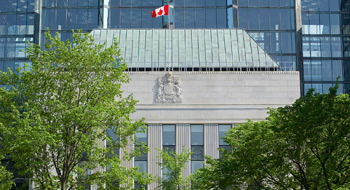

The Bank of Canada says it expects the oil-price shock likely “stalled” the country’s economy to the point it had zero growth during the first three months of 2015 but that it has decided to keep its key interest rate unchanged at 0.75%.
The central bank justified Wednesday’s rate decision by saying it expects positives in the non-energy sector to re-surface and the economic pain from the oil slump to fade.
It predicted those improvements to show up in the form of more exports, investment and job opportunities.
Read: Modest growth expected despite low oil prices: Russell
“As the impact of the oil-price shock on growth starts to dissipate, this natural sequence is expected to re-emerge as the dominant trend around mid-year,” the bank said in its latest, quarterly monetary policy report, also released Wednesday.
The bank said it expects the Canadian economy to be boosted by the surprise quarter-point rate cut announced in January and to growing U.S. demand, which it predicts will bounce back after temporarily slowing in recent months.
Read: Global growth to pick up in 2015 and 2016: Expert
Its outlook for inflation, the key indicator behind rate decisions, is “roughly balanced.”
But the central bank warns the economy will first have to ride out the negative effects of the oil slump, which it says were even more “front-loaded” than expected for the oil-exporting country.
The bank reduced it its first-quarter projection for Canadian real gross domestic product to “essentially no growth” from the 1.5 per cent prediction it made in January.
“The bank now expects that the Canadian economy stalled in the first quarter of 2015,” the report said.
Read: 11 predictions for 2015
Last month, Bank of Canada governor Stephen Poloz told the Financial Times in an interview that the oil-price shock would make the economy’s first-quarter numbers look “atrocious.”
In a March speech, Poloz also expressed concern about the second quarter: “We’ve got our fingers crossed.”
It said Wednesday that its now estimating the economy will grow 1.9% for the full year, down from the January estimate of 2.1% growth over last year.
For the second quarter, which began April 1, the bank is estimating 1.8% growth, up from 1.5% in January.
Read: Expect BoC rate cut, loonie to continue drop: CIBC
For 2016, it’s predicting 2.5% GDP growth next year followed by 2% growth in 2017.
The Bank of Canada said the continued volatility around crude prices means the “ultimate size” of the impact from the oil slump will have to be watched closely, though the magnitude of the economic fallout will vary by region.
